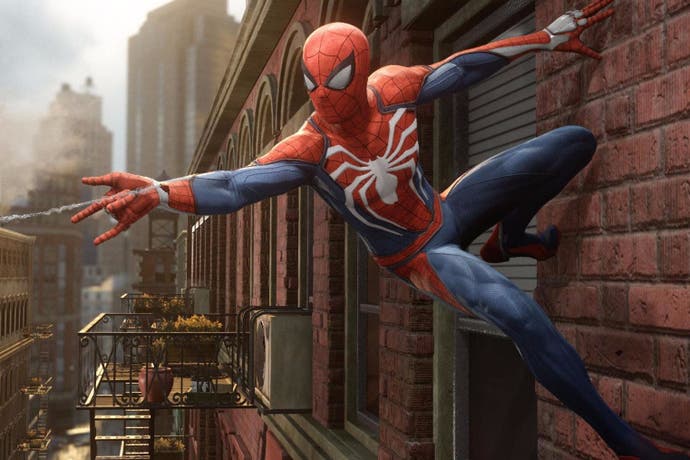Spider-Man reaches new heights on PS4 Pro
Smart rendering techniques combine for one of Pro's best presentations yet.
Insomniac's Spider-Man was one of the highlights at this year's E3, with Sony showcasing the game running on PlayStation 4 Pro, hooked up to a top-end Sony ZD9 UHD TV - one of the best HDR sets on the market. The extended demo sequence shown off by the developer takes us through combat atop a partially constructed skyscraper to an epic helicopter chase through the New York skyline. It's a carefully chosen slice of gameplay taken from one of the main story missions, giving us a first look of what to expect from the game in terms of sprawling environments, large set-pieces, and how the core gameplay mechanics allow for some impressive physics-based action. It also looks quite stunning - if this is the standard of second-gen PS4 Pro titles in the pipeline, users of Sony's 'super-charged' console have much to look forward to.
Digital Foundry sat down with the developer at E3 to look at the game, and outside of the gameplay demo, details were sparse about the core nature of the title - is it open world or not? Insomniac simply said that it 'wasn't talking about that' - which as a media-handling tactic, isn't exactly helpful. However, the session was useful and exciting in that we can confirm that the title's beautiful E3 gameplay demo at the Sony media briefing is indeed entirely representative of real-time gameplay, and an excellent endorsement of the 'smart' GPU rendering techniques that allow PlayStation 4 Pro to produce some outstanding imagery for ultra HD displays.
Just like Ratchet and Clank, Insomniac is using a technique called temporal injection to simulate a 4K image, where four million jittered samples are used to reconstruct a 2160p frame. It's not native 4K, but results hold up on a UHD screen at close range with the presentation appearing smooth and refined. We're not looking at crystal clear, pin-sharpness here, but the game is aiming for a CG-like aesthetic, which traditionally delivers a slightly soft, but smooth look that still features plenty of fine detail. Integrated with Insomniac's excellent post-process pipeline, the results here are convincing enough to simulate native 4K, and the game's cinematic look is quite striking, with a blend of hyper-realistic and natural qualities across characters and environments.
The shader work for various materials stands out, with the threads in Spider-Man's suit reacting to light in a completely different way to concrete, plastics, and other elements in the world. This physically-based rendering approach works well in helping to craft a CG-like look for the game, although the world is still very stylised, with the demo featuring a vibrant, bright daytime setting you might expect from a colourful superhero title. Think precision CG melded with a comic book aesthetic and you get some idea of Insomniac's approach here, and it pays off handsomely.
Post-processing is also heavily used to further infuse a cinematic feel to the presentation, mainly via depth of field and motion blur. In particular, Insomniac's object blur implementation is one of the most impressive we've seen to date, delivering extra smoothness and cinematic flair to the 30fps presentation without any noticeable artefacts. A high level of sampling means that there's no banding in motion, giving a more natural look to action and helping to mitigate the half-refresh frame-rate.
The visual package is similarly strong in other areas too, with high quality shadows, reflection maps, physics-based particles, and accomplished use of dynamic lighting for projectiles. There's a sense that Insomniac's engine is capable of delivering beautifully detailed environments without too many compromises with regards to the quality of the effects work - but at the same time this begs the question of how visual quality will hold up outside of this curated slice of gameplay.
If Spider-Man does embrace open world gameplay, the rendering challenges stack up. Typically, sandbox titles tend to suffer from compromises such as visible pop-in and low resolution shadows, to help deal with the demands of rendering massive environments. But these trades are mostly absent in the demo, with just a few mild instances of LOD switching as Spider-Man swings through the city. However, we're optimistic with the outlook here: Insomniac has been working with an open world engine since Sunset Overdrive, and since then it has had several years to refine in-house technology to help reduce LOD streaming issues, and better optimise for large open environments.
Coming out of the Sony E3 presser, the main criticism of the demo concerned the apparently linear nature of the gameplay and the inclusion of button-mashing Quick Time Events (QTEs). Certainly, the demo appeared tightly scripted with the action moving from one sequence to the next, peppered with tightly directed cutscenes and set-pieces. However, we were informed by Insomniac that players could fall back during the helicopter chase, fail some of the QTEs, and still complete the mission, suggesting a fair bit of freedom is possible - a state of affairs we'd expect to persist through gameplay, not just the single mission we saw.
One thing that does come across clearly is how fluid the gameplay looks, with Spider-Man seamlessly jumping across the environments, attacking enemies, and throwing around objects using his abilities and webbing technology. There's the sense here that while the player is gifted with Spidey's superhuman powers, they need to be used within the stringent rules set by the game world. For example, one of the main design goals for Insomniac was to have Spider-Man's webbing attach to tangible objects in the world to create the feeling that the player is fully interacting with the city as they swing through it - a far cry from early Spider-Man titles, where his webbing attached to imaginary surfaces somewhere above the player viewpoint.
The difference is clear in the demo, where swinging through the city sees clear attachment points for the web lines, and also through object manipulation, where cranes, vehicles and boxes are manipulated to impressive effect. This makes it feel like the world is there to facilitate various gameplay possibilities, rather than just to give Spider-Man a large environment to explore.
In this respect, it's the most authentic interpretation of the character in gameplay terms we've seen so far - and it's also interesting to note the inclusion of new toys, like proximity-based web traps. Insomniac is aiming for an older Spider-Man here, experienced with his abilities and who has invested time in improving his arsenal of gadgets. An aspect of the character often overlooked in gaming is the brain of Peter Parker, science nerd and proud of it.
Also worthy of praise in Spider-Man's E3 demo is the quality of animation in the demo and its use in engine-driven cutscenes. Use of animation blending and layering ensures that Spider-Man moves around the environment smoothly when jumping and attacking multiple enemies, and this allows for combat to flow in a more realistic manner compared to past Spider-Man titles. The level of fluidity here enhances the game's many interactive set-pieces, such as Spidey's leaping and sliding through an office building as it is blown apart, or attempting to stop a falling crane from crashing to the ground. In short, the fidelity of the rendering here means that Insomniac doesn't need to rely on pre-rendered video sequences, and there's more continuity between cutscenes, QTEs and gameplay.
While the lack of a true 60Hz feed prevents us from performing a detailed frame-rate analysis of the E3 code, eyeballing the developer presentation showed a solid showing here overall, with only a few mild drops at one point where Spider-Man is running through an office building as it gets blow apart. Previous Insomniac titles - such as Ratchet and Clank and Sunset Overdrive - mostly ran smoothly, so we aren't expecting any major issues in this area, based on what we've seen so far.
Overall, it's solid showing for the game so far, and it's heartening to see that the game is able to deliver in real-time the high quality visuals we first saw in motion at the PlayStation Meeting reveal last year for PS4 Pro. On top of that, gameplay is shaping up nicely - the combination of Spider-Man's abilities and the title's excellent handling of physics within the environment looking really promising. Of course, the demo is just a small sample, so it will be interesting to see how the gameplay holds up, plus we'll be fascinated to see how the base PlayStation 4 version compares to this almost pristine PS4 Pro presentation. If it's anything like Ratchet and Clank - based on similar rendering technology - this shouldn't be a problem.

















